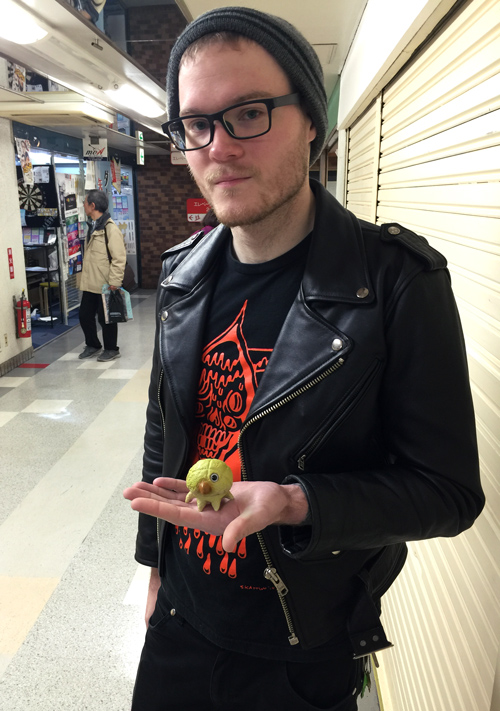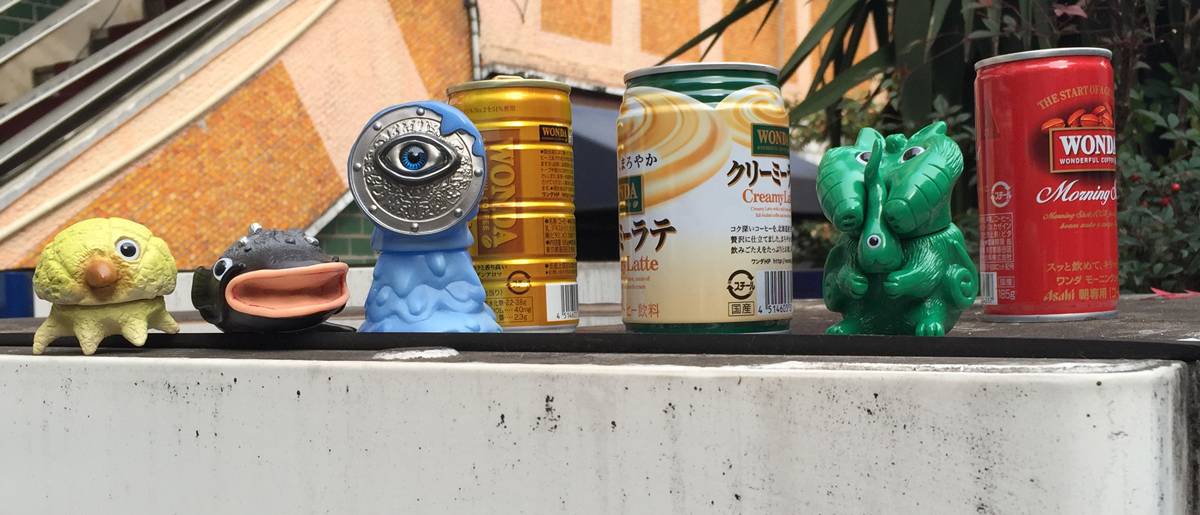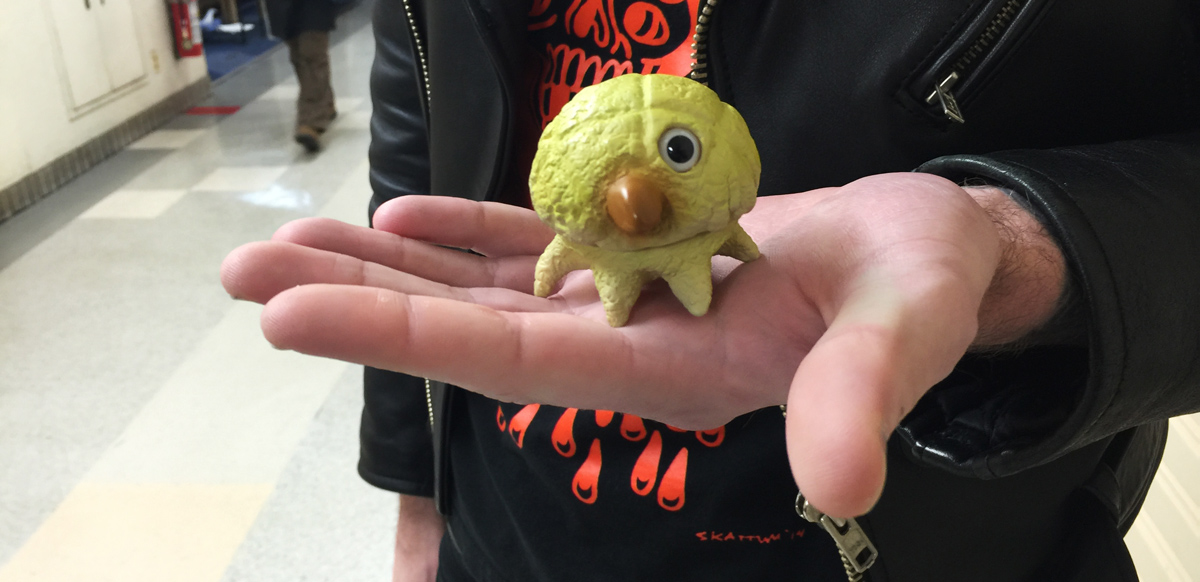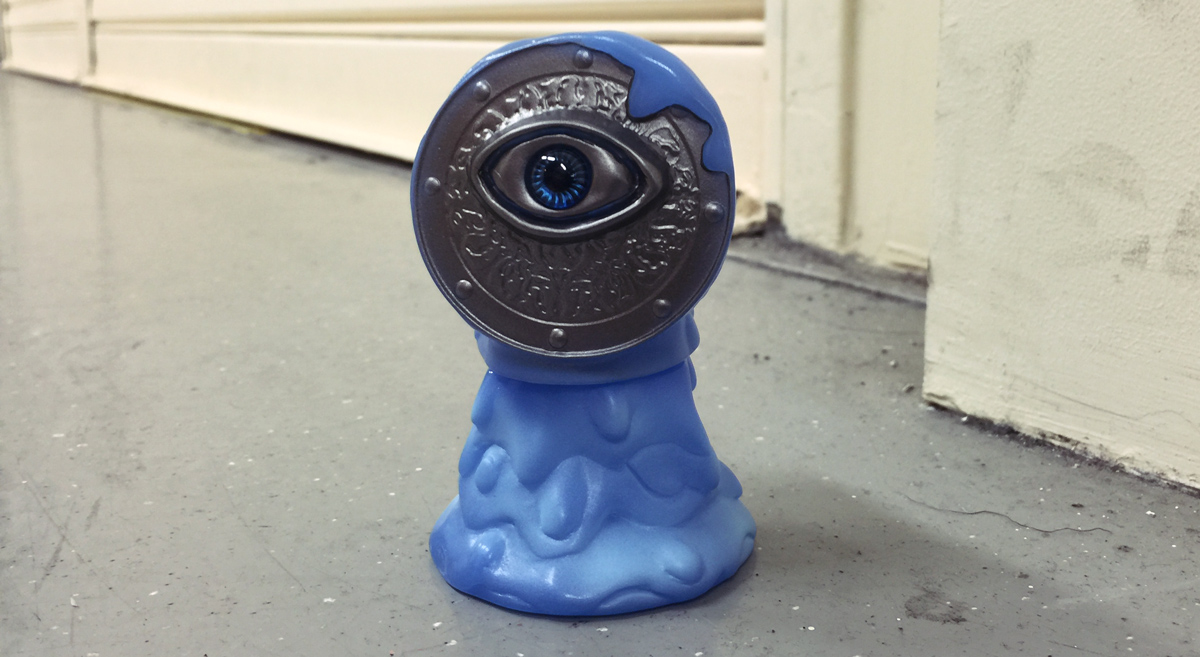A short train ride from Shinjuku station is Nakano Broadway which, from the outside, blends in with much of Tokyo’s sprawl. While not exactly a cultural landmark, this shopping center has a little something for everyone: used CDs, discount clothes, groceries, vintage stamps. It also happens to be a hub for otaku and other subcultures, as well as home to Mandarake, Japan’s most popular second hand otaku/anime/manga/idol/you-name-it goods retailer. It was there, on a brisk January afternoon, I met with Cory Privitera, former member of the US Army and children’s hospital employee, now living in Tokyo where he makes monsters. Small, vinyl monsters. Tokyo has a pretty eclectic mix of denizens, but Cory — dressed in a leather jacket and jeans like a lost, kinda nerdy member of The Ramones — sticks out.
Cory came to Japan to create sofubi. Sofubi refers to vinyl toys that came out of Japan in the post-war years and at first depicted popular heroes and monsters like Ultraman, Devilman, and Kamen Rider. These sofubi, as well as other similar toys, are popular enough that Mandarake has devoted whole storefronts just to selling them. The medium has also attracted a breed of artists, from both the US and Japan, that are making their own monsters. Far removed from the mass produced Funko Pops choking store shelves in the US, these artist-made sofubi are bizarre amalgamations of elements from monster movies, comics, cartoons, mythology and video games, molded together with the artist’s own personal touches.
Cory and I spent the afternoon walking the corridors of Nakano Broadway and talking about what it’s like being an American making Japanese monsters far from home.

Who are you and how did you get started?
I’m Cory, and I got started being super interested in toys. I was more or less obsessed with Japanese vinyl toys. Sunguts, Real x Head, Secret Base. I always wanted to make stuff.
Do you consider America or Japan your home now?
I used to think I’d go home and be all nostalgic. I’m originally from Buffalo but I spent most of my life in Boston. I went back recently and I’m so used to it here for the last few years that Boston doesn’t feel like home anymore. Not in the sense that I’ve integrated into the [Japanese] culture whatsoever, but I like the things here more. And visiting family back in Buffalo, that just felt even more foreign because I hadn’t been there in so long. This feels like actual home home. But not in the cultural sense. I’m still very much not used to this world, but the locations are comfortable.
I kinda came here on a whim because I wanted to do just anything. I was in the army for ten years and then I worked in a children’s hospital. It was all fun, but then I had a quarter-life crisis where I wanted to do something more interesting. I wanted to move to Japan and do something fun with my life before I settle down with a career. Then I came here without ever studying Japanese. I actually still don’t ever study Japanese because I’m always making stuff, but eventually I plan on getting in there.
Did you have a plan coming over?
I had actually come to Japan to be an English teacher, initially, because that’s the easiest way in and you just go from there. A lot of people just come in on the easiest form of visa and realize “oh, there’s a million other things I can do.” I was asking Ricky of Velocitron to produce a toy of mine and I had just seen on his Instagram that he had just relocated, and I was like I’ll ask him if he needs any help. So he ended up teaching me everything from the basic step by step how to do the basic stuff like molds, wax working, and getting the prototypes… After about a year of working with him I ended up doing my own toys and I’ve been doing my own toys since then.
Who are some the people making these toys? Are they Japanese, American?
It’s every walk of person. There are people who come over here. There’s a guy we’re all really close to named Dennis, but he goes by Shirahama. He makes a figure called Kumon, it’s a spider with a skull face. He’s another westerner that came here. There are guys that came here, and from what I understand, had very little knowledge of the process but picked up and learned. Then you have guys in the States who do all their prototyping and send them out [to Japan for production]. They’re still figure makers but they do them through some proxy here.
Is there any kind of collaboration between sofubi makers?
There’s a lot of talking and collaboration. Rampage Toys, Jon [Malmstedt] has a small gallery and does a ton of collaboration with guys. He talks to companies, talk to other producers, and does these weird mash ups. Some are like a figure sculpted and designed by a guy, and painted by another. Some will sculpt the head for the body or the body for the head. You get these collaborative pieces.
So why did you want to make figures?
I’ve always liked things you could physically hold in your hand. One of my favorite toys back from when I first started coming to Japan years ago was, you know, Danbo from Yotsuba&? The little Danbo toy, you always see photos of it everywhere. People taking photos of him with their coffee or whatever. I thought that was so cool because there was kind of this culture behind it. And you start seeing that with people making micro and mini sofubi. There’s a vinyl gashapon series made by Medicom and people have been buying those and been like “here’s the thing in this little field, here’s the thing on vacation with me.” I thought that was really cool because it was like free advertising for these really cool toys, but it’s also part of someone’s life. It’s something they always have with them, it’s not just sitting on a shelf all the time. That was always cool to think that someone is bringing a thing that you made with them. That’s what got me into that.
What were your first attempts at making figures?
I got some super sculpey and just played around with it forever, trying to copy some figures that existed and the angles and shapes that actually made them work. I thought they all looked horrible so I just destroyed them and kept going on and playing with them. That was really the introduction to learning how to sculpt for toys.
What are the events here we would see your toys at?
The big one is Super Fest. It’s a garage sale, more or less, of just toys. There are people that sell old retro toys, or people that sell new toys that just came out and they want to turn them around. There’s usually a separate area for people that just make sofubi. It’s people doing new figures, all walks of the sofubi community, people that make cheap stuff, people that make expensive stuff. It’s really cool. It’s small, but it’s the best sofubi event.
There’s also Wonder Fest, which issues one day licenses if there’s a character you want [a toy of] from a franchise you don’t own. I did one from a manga called Goodnight Punpun. When you got the okay from the publisher you can make the thing and say it’s a licensed product for that one day. People have made the bonfire from Dark Souls, Parappa the Rapper’s hat. It’s less about independent original ideas and more about those licenses. Then there’s also Design Festa, which is this giant international show, it’s people from all over the world. It’s over at Tokyo Big Sight, it’s this huge huge thing. It used to just be crafts and art and then it slowly evolved into everything, and now it has this huge sofubi community that goes there.
What was your first Super Fest like?
The first was 2015, I worked a table with Ricky and Luke. I had three figures that came out and it was a decent show, but it’s hard when you first start out. People don’t collect your stuff, unless you have something incredibly interesting or a lineage. It’s kind of difficult to make an impact at your first show. It was good, but I felt like I should have planned more for this. Maybe used Twitter or Instagram more to network myself because it was all very slow coming in the beginning. I was not too skilled at advertising to the Japanese market.

We made our way through the densely packed Nakano and found some respite in a quiet cafe tucked away in a corner of the mall that’s owned by Superflat artist Takashi Murakami. Cory pointed out that “…he’s there semi-frequently whenever he’s in Tokyo. It’s funny ‘cause he always looks really strung out.”
Do you make toys full time?
All I do is toy making. As soon as I realized it was a possibility to live here- I started a company here and that’s how I sustain my visa. I do toy production, I do toy painting, I might as well include every single step so everything I do can technically be considered work. Every single thing I do is related to toys one way or another.
Was it difficult getting that set up?
It was kind of a pain in the beginning because I didn’t know how to do it, but then I ended up encountering a super super knowledgeable lawyer that set up stuff for it. I wanted to make sure I didn’t have to get another job or was required to work another job to maintain a visa. So every single toy thing I do is technically considered work. I can also write off on, and pay taxes on and report on all that stuff as a business. Now picking up stuff isn’t just a side thing or a hobby, it’s a business. It’s this big conglomerate toy thing of a one person organization.
After climbing a few stairs and passing through a few halls we came to a shop full of shelves lined with hundreds of small, unpainted, rubber figures known as keshi. These toys were a cultural touchstone for Japanese children in the 70s and 80s and even were imported to the US as M.U.S.C.L.E and Monster in My Pocket toys.
This used to be a little store that sold Kinnikuman goods. You know Keshi figures? They have on display some Wonder Fest ones people have done for video games. There’s a guy making a series of killer chibis from movies. He did Texas Chainsaw Massacre but did it in the Bikkuriman art style.
Cory gestured to a rack lined with square stickers, a tad larger than a postage stamp, with colorful depictions of gods and monsters.
People online say that Bikkuriman was the first instance of a rarity based variant collection thing in common collection history. Bikkuriman had these disgusting cookies and they come with these little stickers of a character, and the character is usually a reference to things in Japanese culture, or monsters, or bizarre original creations. And they had different levels, like Angel Seals, Devil Seals, God Seals, and they would be shiny or not shiny depending on the rarity or level of those seals. And over time certain variants of those now are like thousands of dollars for one sticker.
What are your stylistic influences? Where do the ideas for what you sculpt come from?
Old video games. My favorite artist is Sun Guts, he’s the leading yokai figure designer. I continue to make a lot of yokai themed ones, but cutesy yokai. His art style and a lot of his figures are based on the Gegege no Kitaro franchise. I’m a big fan of Neclos Fortress, which is like a series of keshi figures and I like how they look like old school RPG monsters, like something you’d seen in a sprite era RPG like Faxanadu or Lufia. I’m just trying to convey those types of strange monsters in sofubi, which is difficult, but it’s fun when you get it done because people kind of recognize it.
We left Nakano Broadway and explored the labyrinthine side streets surrounding the mall. Hairdressers, cheap restaurants, stray cats, and liquor stores packed tightly together. Cory directed me towards World Kaikan, a dilapidated former hotel, now home to a few odd establishments and a host of urban legends. A dive bar run by a Buddhist monk, a karaoke joint that caters to fujoshi, and a Jojo’s Bizarre Adventure themed pub are some of the businesses tucked away in the garish mustard-yellow building surrounded bikes, garbage, and discarded vending machines. A perfectly suitable place for Cory’s monstrous creations to inhabit.

It’s supposed to be a melon pan krakken, like the mythological octopus monster, but it’s melon bread. It’s super cute and I made it on a whim. I had wax pulls of a melon pan that I made a Metroid out of. I just hacked an eye hole and hacked a little body and put a beak on it and it came out super good looking.

That’s a Namazu, an earthquake catfish. In Japanese folklore they believe earthquakes are caused by a giant catfish with a rock on his head. It was placed there by a deity of some sort and when he gets the rock off his head he thrashes about and that causes earthquakes to happen.

This is a slime, it’s heavily based on the Dungeons & Dragons and Neclos Fortress (a line of keshi toys from the 80’s) style character where it’s a strange kind of monster you’d see in a dungeon.
What’s your process for making/designing toys?
I always have a notebook with me and if I see something interesting that I like from a video game, from an anime, from a tokusatsu show. Even just walking around here [and looking at] the old keshis and figures, things will just jog my mind. Oh, I like how this robot’s arm works, or I like the eye structure on this character, and I keep a log of notes. I almost never sketch, I’ll usually just mold stuff and get a shape going, but every so often I will experiment with a few ideas and see what works better. For the Namazu catfish toy, originally it didn’t have the craigs and little rocks and stuff and it was kinda lame. What would make it cool? I was on a road trip and ended up seeing an ad for some Japanese communications company. It was talking about earthquake preparation and it had a catfish with a road on it with little cars and it was making them bounce like in an earthquake. I was like that’s a really good idea, so I took crags and rocks and added that to it and it was way better.
I just take inspiration from everything. I read a lot of video game art books. There’s an Instagram called Famicom Necropolis that puts up old character art books. They had stuff from when they didn’t put the sprites in the books, they just had these really elaborate drawings of what the thing was supposed to look like. I don’t even need to sketch, I have all these things in my mind, so I just play around and see how it turns out.
Any favorite haunts in Tokyo?
Mandarake. Microkan [One of Mandarake’s storefronts in Nakano Broadway – Ed.] has all the keshi, and just seeing all the things made into keshi are so weird. Everything imaginable has been made into a keshi. Even the Kinnikuman figures are so bizarre, they have so many weird characters. It’s good inspiration, I collect a lot of that stuff. All the Mandarake here in Nakano Broadway are specific. One is all keshi and strange little toys, and the one we passed by earlier was for modern sofubi, there’s one for early sofubi, then there’s also a lot of other shops around here. It’s a good hang out to see things, even though it’s kinda like the movie Mallrats, with the dirt mall. It’s a Japanese dirt mall, but it’s cool. To people outside the interest it feels like a flea market, a big dirty flea market, but it’s so much cooler than that. And just walking around Japan has a lot of weird shrines and statues and seeing everything is fun. You can just walk around and not be bored here because there’s so many things to see. Other than that I spend a lot of time in Koenji, which is actually where I live.
Parting words for the viewers at home?
Make stuff. I don’t make stuff, then I force myself to make stuff and it’s like “oh, I can make stuff.” Anyone can make stuff. It’s not as unattainable as anyone thinks. The people that make resin, they think they can’t make sofubi, but they can totally make sofubi. The people that don’t make anything can totally make resin. It’s one of those things I didn’t realize was so easy to learn from just practicing. It’s very obtainable, it’s a thing people can do. In regards to toys, thanks for all the support, I’m glad people like the things I make. It’s a surprise and interesting to see people posting or getting excited about released. I never thought I would be in that position where people are excited about a thing I made. Thanks, everyone!
You can follow Cory on Twitter and Instagram

Support us on Patreon!
Contributor articles like this are supported in part by our readers. If you enjoyed this content, please consider supporting Zimmerit on Patreon.


